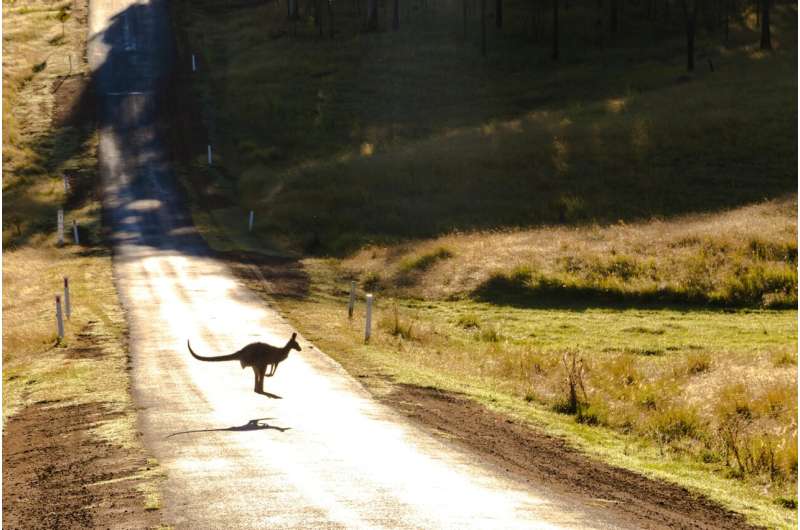This article has been reviewed according to Science X's editorial process and policies. Editors have highlighted the following attributes while ensuring the content's credibility:
fact-checked
trusted source
written by researcher(s)
proofread
Should WA and NT drop rural default speed limits to 100kph? Here's what the evidence says

The spotlight is back on speed limits, as the Western Australian government prepares to host a road safety summit in early September. Ahead of the meeting, at least one expert has called for the WA government to lower default speed limits on rural roads in WA to 100 kilometers per hour, down from 110 kilometers per hour.
While every other state and territory in Australia has a rural road default speed limit of 100 kilometers per hour, the default limit on rural WA and Northern Territory roads is 110 kilometers per hour.
So, would dropping the default limit by just 10 kilometers on country roads in WA and NT make a difference? And how might it be enforced? Here's what the evidence says.
Would it make a difference, and how do we know?
Theory tells us that the faster the speed at which a vehicle crashes, the more likely it will result in serious or fatal injuries. There is a limit to what the human body can withstand.
Now let's look at what has been found in practice.
Research we conducted at the Center for Automotive Safety Research showed the risk of serious and fatal injury in all impact types was reduced from 4.6% at a travel speed of 110 kilometers per hour to 3.3% at 100 kilometers per hour. That's a reduction of about 28%.
For head-on impacts, the risk of serious and fatal injury fell from 20.9% to 12.2%—a 41% reduction.
But will reducing speed limits actually reduce the speed at which people travel?
In 2019, a group of researchers reviewed studies that reported on 26 changes in average travel speeds due to changes in speed limits. This included results from three Australian studies.
The review found cutting the speed limit by 10 kilometers per hour may be expected to reduce the average actual travel speed by three kilometers per hour.
In other words, even if people didn't slow down a lot, they still slowed down a bit, which helps reduce risk.
And over time, as drivers get used to the new lower speed limit, they may slow down even more.
But do crashes actually go down?
Yes. Studies from around the world have shown that, generally, when speed limits go down, crashes go down. This is true for both injury crashes and fatal crashes.
The same pattern holds true in Australia, too.
Australian studies looking at the effect of reductions from 110 kilometers per hour to 100 kilometers per hour found injury crashes were reduced by:
- 19% in Victoria
- 27% in South Australia, and
- 27% in New South Wales.
Would a speed limit change really help, given how much rural roads vary in quality anyway?
The default rural speed limit applies to all roads outside of towns and cities (except where a different speed limit has been posted).
And remember: just because the default rural limit is lowered to 100 kilometers per hour, it doesn't mean that will be the limit for all roads. Some roads may still have higher or lower speed limits.
A lower default speed limit on rural roads makes sense because it would make drivers safer on already poor quality rural roads.
Many rural roads are undivided, narrow, have no shoulder, or are unsealed. They may have hazards such as trees close to the edge of the road. Hazards such as livestock, wildlife, heavy vehicles, agricultural vehicles, or mining vehicles are common.
For these reasons, many rural roads are better suited to lower speed limits.
On the other hand, a high quality road—like a freeway or highway with divided traffic flows, sealed shoulders, dual lanes or passing lanes, few or no intersections, and roadside clear ways or barriers—may be better suited to a higher speed limit.
Could a lower default limit on rural roads even be enforced?
Setting safer speed limits is just one part of the picture.
While the majority of road users obey speed limits, enforcement is necessary. Police already enforce the current speed limits in rural areas, mostly by traffic patrols, and would continue to do so if they are reduced.
Technology can also play a part. Authorities often use safety cameras to monitor driver speed and other behaviors throughout Australia.
In particular, mobile point-to-point safety cameras (which can be moved to different locations to measure travel speed and enforce limits) are likely to enhance enforcement in rural areas and have been trialed in Western Australia.
Overall, the evidence is clear. Lowering the default rural road speed limit from 110 kilometers per hour to 100 kilometers per hour in WA and NT would be a positive for road safety.
It's a change that could save lives.
This article is republished from The Conversation under a Creative Commons license. Read the original article.![]()




















